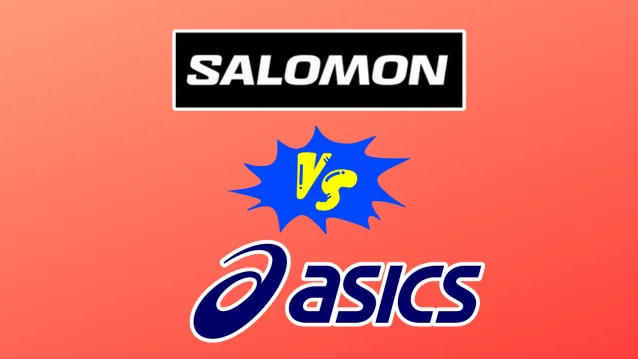As two pioneers in athletic footwear, Salomon and ASICS have become household names for runners and outdoor enthusiasts alike.
But when it comes to choosing between these trusted brands, which comes out on top? This in-depth comparison breaks down the key differences every shoe lover should know.
Comparison Table Between Salomon And ASICS:
Here is a simplified comparison table between Salomon and ASICS:
| Category | Salomon | ASICS |
|---|---|---|
| Founded | 1947 | 1949 |
| Comfort Features | Contouring uppers, adjustable laces, custom arch support | Gel and FlyteFoam cushioning, some models fit orthotics |
| Color Options | Wide range of muted, outdoorsy colors | Diverse vibrant and neutral colors |
| Durability | Durable ripstop fabric, high-traction Contagrip outsoles | Breathable mesh uppers, abrasion-resistant rubber outsoles |
| Price Range | $80-$300 | $50-$250 |
| Style | Outdoor-inspired aesthetic, focus on performance | Athletic heritage, increased lifestyle offerings |
| Popularity | Less mainstream but popular for trails | Global athletic giant, extremely popular |
| Best Seller | Speedcross 6 | Gel-Kayano 30 |
Salomon Overview
Salomon was founded in 1947 by François Salomon in Annecy, France.

Originally a metalworking shop, the company transitioned into ski and outdoor equipment in the 1990s.
Today, Salomon produces high-performance shoes and boots designed for activities like trail running, hiking, and skiing. Some key technologies include:
- Sensifit system: Designed to cradle the foot for a secure, snug fit
- Endofit technology: Interior sleeve hugs the forefoot for customized comfort
- Contagrip outsole: Provides durable traction on varied terrain
- EnergyCell midsole: Offers responsive cushioning that retains bounce over time
Salomon shoes have an athletic, outdoorsy style with bright color options. They’re built to handle tough terrain while providing foot-hugging comfort and support features to aid stability. The brand is especially popular among trail runners and hikers.
Asics Overview:
Asics was founded way back in 1949 by Kihachiro Onitsuka in Kobe, Japan.

The name “Asics” actually comes from the Latin phrase “anima sana in corpore sano,” which translates to “healthy soul in a healthy body.” Asics shoes really align with that mission, aiming to provide runners with equipment that enables peak performance.
Throughout its long history, Asics has continuously innovated and evolved its shoe technologies.
Key components that provide the renowned Asics fit and feel include the IGS (Impact Guidance System) for a natural gait cycle, Trusstic System tech for light stability, SpevaFoam cushioning for soft landings, and Dynamic DuoMax support for optimal alignment.
The outer soles utilize Asics’ specialized rubber compounds called AHAR (Asics High Abrasion Rubber) that hold up to heavy mileage on roads.
From fast, feather-light racing flats to well-cushioned trainers, Asics offers a diverse range of running shoe models to suit different needs.
But across the board, Asics shoes are known for their structured, classic look and feel.
If you want a running shoe with proven performance and durability from a brand that’s withstood the test of time, Asics is a solid choice.
Major Differences Between the Brands
Comfort and Fit
Both brands accommodate a spectrum of foot shapes thanks to customizable lacing, removable sockliners and precision engineering from heel to toe.
However, Salomon trail shoes contour snugly around feet to stabilize on uneven topography using SensiFit and EndoFit technologies while ASICS emphasizes plush cushioning for road running via GEL systems.
Durability and Performance
Salomon builds rugged shoes to withstand outdoor abuse like sharp rocks under aggressive grip patterns while ASICS tests road shoes for hundreds of miles against abrasion. Both perform admirably but Salomon ultimately edges out the win for resilience against the harshest mountain conditions.
Price
Salomon shoes skew expensive starting around $150 given the technical construction while ASICS core offerings average $100. However, both brands offer accessible models under $80 making either an option regardless of budget constraints.
Design and Style
Salomon sticks to an earthy, outdoorsy look across the board while ASICS, an athleticwear giant, nods subtly towards retro running style in many classic models. For fashion-focused buyers, ASICS variety of patterns and colors stays on trend season after season.
Popularity
ASICS edges out Salomon substantially in global brand recognition and market share. But Salomon remains renowned for pioneering trail running shoes long before hitting mainstream consciousness.
Target Market
Salomon targets competitive trail runners, hikers and mountaineers seeking grippy, protective shoes. ASICS appeals broadly to urban runners and athletic enthusiasts wanting an everyday workhorse shoe that goes the distance in both performance and lifestyle wear.
Performance Comparison
For Nurses
The Gel-Kayano 28 provides excellent cushioning and support for nurses spending long shifts on their feet. However, certain Salomon hiking boots have slip-resistant outsoles optimal for medical settings along with waterproof protection. Toss-up!
For Walking
ASICS walking shoes like the Gel-Tech Walker Neo 4 properly stabilize feet during casual strides while many Salomon options have rigid midsoles that restrict natural motion. Point goes to ASICS here.
For Running
Avid road runners prefer ASICS trusted cushioning technologies like FlyteFoam and Gel which minimize pounding on pavement. But Salomon trail runners perform best on rocky, angled topography where grip and foot locking are essential. Different terrains, different winners!
For Flat Feet
Stability shoes are critical for flat feet at risk of overpronation. ASICS GEL-Kayano models provide excellent motion control while Salomon trail runners lack medial support. Another checkmark for ASICS.
For Back Pain
Salomon hiking boots with custom orthopedic insoles can potentially alleviate certain types of back pain. But ASICS supportive Gel cushions more consistently prevent and protect against discomfort mile after mile.
For Standing All Day
Cushioning kings like the ASICS Gel-Nimbus 24 absorbs shock significantly better than rigid Salomon models. Standing in ASICS is pure cloud-like comfort.
For High Arches
Salomon supplies various replacement insoles to custom tailor arch height and shoe volume. Not all ASICS accommodate such adjustments so Salomon better serves this need.
For Hiking
With superior traction lugs and Contagrip compounds built for rugged terrain, Salomon hiking boots outperform on the trails, hands down.
For Plantar Fasciitis
Certain ASICS walking shoes provide optimal arch support and heel cushioning to relieve plantar fasciitis pain. Salomon trail runners lack features to specifically address this. Advantage, ASICS!
Final Verdict
At the end of the day, choose Salomon trail shoes for conquering cragged mountain paths and ASICS road shoes to clock mileage around the neighborhood.
Whether blazing new records or meandering mindfully, both brands deliver quality and innovation step after step even if priorities differ. For navigating rocky ridges, slip on Salomon and feel the earth underfoot.
To float effortlessly along smooth pavement, ASICS Gel and Foam cushioning can’t be beat. Hopefully parsing preferences helps decide which shoe giant to lace up with on your next adventure!

